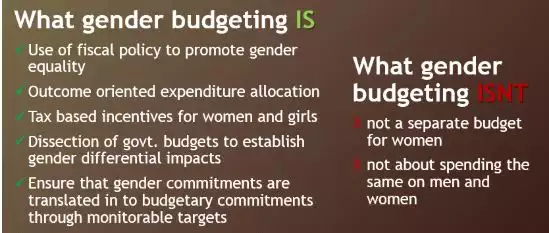Gender Budget Statement 2024-25 | 31 Aug 2024
For Prelims: Gender Budget,2024-25 Budget,Gross Domestic Product(GDP),total budget expenditure,PM Kisan scheme,MGNREGS, PM Employment Generation Programme (PMEGP), Sustainable Development Goal 5, Mission Shakti
For Mains: Gender Budget, Issues and Challenges Involved in Gender Budgeting in India
Why in News?
The 2024-25 Budget emphasises women-led development, with Gender Budget Statement (GBS) allocations reaching 1% of Gross Domestic Product(GDP) for the first time and pro-women funding exceeding ₹3 lakh crore.
What are the Key Highlights of the GBS 2024-25?
- Rise in Pro-Women Allocations: The share of allocations to pro-women schemes has risen to approximately 6.8% of total budget expenditure for 2024-25, up from the historical average of around 5%.
- New Reporting Structure - Inclusion of Part C: A new section, Part C, now includes pro-women schemes with up to 30% allocation for women, such as the PM Kisan scheme.
- Earlier the GBS comprised two parts – Part A reflecting Women Specific Schemes, such as those with 100% allocation for women such as, SAMARTHYA, which now account for nearly 40% of GBS allocations, partly due to the full inclusion of the Pradhan Mantri Awas Yojana (PMAY).
- Part B reflects the schemes with 30% to 99% expenditure on women-related components, such as, PM AJAY - Adarsh Gram Yojana
What is Gender Budgeting?
- Definition: Gender budgeting is a strategic tool used by governments to ensure the efficient collection and allocation of public resources according to the diverse needs and priorities of different genders.
- Gender budgeting does not involve creating a separate budget exclusively for women but focuses on addressing women's specific needs through existing budgetary frameworks.
- Background: India ratified the Convention on the Elimination of All Forms of Discrimination Against Women (CEDAW) (1979) in 1993, signalling its commitment to gender equality.
- This commitment led to the introduction of the first Gender Budget Statement in the Indian Budget of 2005-2006. Since then, the government has consistently released the Gender Budget Statement alongside the Union Budget.
- Nodal Agency: The Ministry of Women and Child Development (MWCD) acts as the central nodal agency for gender budgeting, and the Ministry of Finance has mandated the establishment of Gender Budget Cells in all central ministries and departments to support this process.
- Gender budgeting falls under the Samarthya sub-scheme of Mission Shakti, an initiative by the MWCD aimed at empowering women.
- Framework for Gender Budgeting: It involves five steps such as:
- Situation Analysis: Assess the status of different gender groups in a sector.
- Policy Assessment: Evaluate if policies address identified gender issues.
- Budget Evaluation: Check if budget allocations are adequate for gender-sensitive measures.
- Expenditure Monitoring: Verify if funds were used as intended and assess results.
- Impact Assessment: Measure the impact of policies on the conditions initially analysed.
- Significance:
- Optimises Resource Allocation: Directs funds to areas where gender gaps are significant, addressing critical needs.
- Supports SDGs: Aligns with Sustainable Development Goal 5, contributing to global efforts for gender equality.
- Enhances Accountability: Provides transparency in fund allocation and usage, ensuring commitments to gender equality are met.
- Strengthens Governance: Integrates gender perspectives into public financial management, leading to more inclusive and effective governance.
What are the Challenges Related to Gender Budgeting in India?
- Over-Reporting: Programs like the PM Employment Generation Programme (PMEGP) show inflated allocations in the Gender Budget Statement (GBS).
- For example, ₹920 crore (40% of the total allocation) is reported without sufficient justification, and more such inflated allocations is a key challenge to the gender budgeting.
- Under-Reporting and Missing Allocations: Critical allocations for women’s needs are often understated.
- For instance, the National Rural Livelihoods Mission (NRLM) is now correctly reported as fully dedicated to women and girls, but this accuracy should have been reflected earlier.
- In another instance, MGNREGS, which benefits women significantly, is reported under Part B with only 33.6% of its total budget. This is inconsistent with the fact that women account for 59.3% of all person days worked under the scheme, and they should have received a larger share of the total MGNREGS budget.
- Additionally, schemes for women entrepreneurs such as PM Vishwakarma, SVANidhi and Stand-Up India are not fully reported.
- Neglect of Key Sectors: Important areas like transportation, water collection, and water security, which have a significant impact on women, are often neglected in gender budgeting.
Way Forward
- Enhance Reporting Transparency and Accuracy: To enhance gender audits and ensure accurate accounting, provide detailed explanations for all entries in the Gender Budget Statement (GBS).
- Ensure accurate reporting of allocations, reflecting true expenditure on women’s needs. Address discrepancies in reporting, such as those seen in schemes like MGNREGS and PMEGP.
- Expand Scope and Coverage: Include more comprehensive coverage of programs affecting women, especially in neglected areas like transportation and water security.
- Regular Reviews and Updates: Continuously update the GBS methodology to reflect the latest data and insights. This should include periodic reviews to assess the effectiveness of gender-responsive budgeting.
- Integrate Gender Sensitivity in Planning: Setting clear gender equality targets and allocating resources accordingly to ensure that government programs are designed with gender considerations from the outset.
|
Drishti Mains Answer: Q. Examine the state of gender budgeting in India, identify the factors obstructing its progress, and propose effective policy measures to foster inclusive development. |
UPSC Civil Services Examination Previous Year Question (PYQ)
Prelims
Q. Which of the following gives ‘Global Gender Gap Index’ ranking to the countries of the world? (2017)
(a) World Economic Forum
(b) UN Human Rights Council
(c) UN Women
(d) World Health Organization
Ans: (a)
Mains
Q.1 “Empowering women is the key to control population growth”. Discuss. (2019)
Q.2 Discuss the positive and negative effects of globalisation on women in India? (2015)
Q.3 Male membership needs to be encouraged in order to make women’s organization free from gender bias. Comment. (2013)

